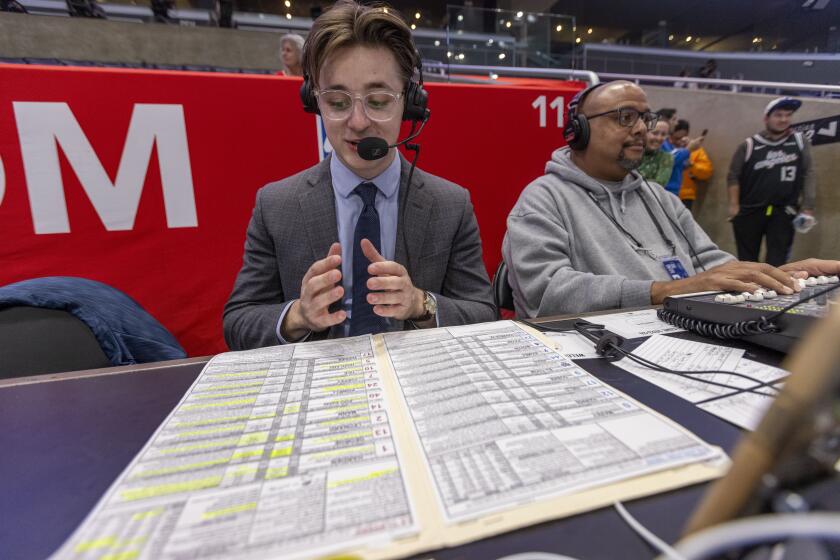Stats show racing has become more competitive
With NASCAR’s Nextel Cup drivers enjoying their last weekend off this season, it’s a good time to take a look at some numbers.
If it wasn’t obvious from the many sellout crowds, the solid TV ratings -- though they are down a bit last year and this -- and the popularity of the stock car racing’s stars, NASCAR’s new statistical analysis shows just how much competition has improved during the sport’s modern era.
In 1970, 22 of the 48 races had only one car on the lead lap at the end of the race.
From 1970 to 1979, one car finished on the lead lap 110 times. In the ‘80s, it happened 16 times. In the ‘90s, only twice. And since 1994, when Geoff Bodine was the lone car on the lead lap at North Wilkesboro, it has not happened at all.
It also used to be common for NASCAR drivers to win by more than one lap. For example, in 1973 at Darlington, David Pearson finished 13 laps ahead of runner-up Benny Parsons and, in April 1977, Cale Yarborough won at Bristol by seven laps over second-place Dick Brooks -- and led all but four laps in that race.
Since then, margins of victory have steadily decreased. Unimpeded runs to the checkered flag are a fading memory. Not so for close finishes.
In May 1993, NASCAR switched from handheld stopwatches or analog timing clocks to integrated electronic scoring. Before that, margins of victory were scored in laps, car-lengths or feet. Now it’s seconds -- or fractions of a second.
Bodine defeated Ernie Irvan by 0.53 of a second in the first race using electronic scoring.
Things have gotten even closer during the last 10 years. Of the closest finishes since 1993, seven of the top 10 have occurred since 2000.
The closest was Ricky Craven over Kurt Busch by 0.002 of a second at Darlington in March 2003. Jamie McMurray’s win by 0.005 over Kyle Busch earlier this month at Daytona is tied for second with Dale Earnhardt’s win over Irvan in July 1993 at Talladega.
So far this season, the margin of victory has been less than a second in 10 of the 19 races.
In six of those events, the competitors were driving NASCAR’s new Car of Tomorrow, which will run a total of 16 races this season and will race the full Nextel Cup schedule in 2008.
The percentage of cars finishing on the lead lap has grown too.
In 1970, only 5.5% of the cars that started the race finished on the lead lap. That number had grown to 43.6% by 2006.
The number of leaders per race has seen steady growth since 1970.
That year, each race averaged four leaders. That number has been at least 10 for the last three seasons, and the average so far for 2007 is 11.
Finally, it has become harder for drivers to dominate the winner’s column.
Richard Petty won 18 races in 1970 and 21 in 1971. Since 2000, no driver has won more than eight in a season.
Through 19 races this year, 13 drivers have visited Victory Lane. In 1970, there were 12 race winners in the entire 48-race season.
*
Sterling Marlin and Joe Nemechek, a pair of longtime NASCAR stars, suddenly found themselves out of work this weekend as the 50-year-old Marlin was replaced by a 23-year-old and the 43-year-old Nemechek was given his release as the Ginn Racing team struggled to find sponsorship and looked to get younger.
Marlin, who remains under contract to Ginn, said in an interview on Sirius satellite radio last week that the move by Bobby Ginn’s team came as a surprise.
“Well, you know, the classiest thing to me would have been to finish the year out,” the two-time Daytona 500 winner said. “I didn’t make it any secret that I was planning on cutting back next year, running 15-20 races.
“But, to do something in midyear, just totally unexpected, you know. Joe [Nemechek] had the same thing happen to him and, you know, it’s sponsor-driven. They’re short on sponsors over there [at Ginn Racing]. Some sponsors were supposed to come through earlier in the year that didn’t come through and times got tight with them, I guess. That’s about all I know.”
On another Sirius show, Nemechek, who switched cars this year to make room for Mark Martin at Ginn, said, “It’s very disappointing, but part of the business is it takes a lot of dollars to make these Cup teams go round and it seems like it never stops. And, unfortunately for myself and the situation, hopping out of the [No.] 01 car and getting in and starting a new team for them, I never dreamed that this would be the case.”
*
The first weekend off for Cup drivers since April couldn’t have come at a better time for Jeff Gordon.
Looking ahead to his time off, the current points leader and four-time champion said, “I’m going to be changing diapers and just hanging out as Dad, and I’m excited. I’m looking forward to it.”
Gordon’s wife, Ingrid, gave birth to a daughter, Ella Sofia, on June 20. It’s the couple’s first child.
“We’re just going to pretty much stick around home,” Gordon said.
“Toward the end of the off-weekend before Indianapolis, we’re going to be in Charlotte with family and some friends that we haven’t had a chance to visit with yet.”
Asked when his daughter will make it to the racetrack for the first time, Gordon said, “I don’t know. We’ll have to see. We’re talking about possibly Indianapolis being the first, maybe just race day.”
More to Read
Get our high school sports newsletter
Prep Rally is devoted to the SoCal high school sports experience, bringing you scores, stories and a behind-the-scenes look at what makes prep sports so popular.
You may occasionally receive promotional content from the Los Angeles Times.






